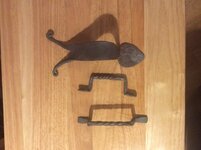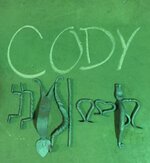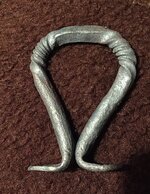I survived day 2 of the class.
I created a couple of design opportunities for my self by working the metal too thin and design elements fatigued as I was working other sections and fell off. I see several possibilities for combining metal work with wood turning and forged a couple of pieces with that in mind. Tapering 5/8" round stock to do spirals takes a lot of hammering. I am tired and sore after 2 days of class.
View attachment 156466
In regards to the highlighted section ....
Just a thought, but couldn't you protect the thinner elements of the design by coating them with dampened ashes or a mud slurry mixture to keep the metal from oxidizing and reducing too far?
I do know that in Japanese bladesmithing, in order to keep the back of a katana from hardening nearly as much as the edge of the blade, so as to give superior flex and support without breaking, they coat all but the edge of the blade with a mud mixture that contains a large amount of ash. This keeps the blade's spine from oxidizing as much in the fire, and, when quenched, the blade achieves a much higher hardness as it is cooled fast enough, but the spine inside the mud coating stays hot far longer and cools much more slowly.
The resulting differential between the hard edge and the softer spine gives a distinctive line down the blade that is called the "Hamon"... This line also demarks where the polishing of the blade changes it's appearance, and where the life of the blade will meet it's end, if it is sharpened or ground past the line where there is no more hardened material left for the edge.




